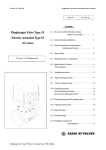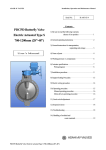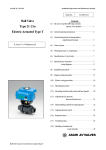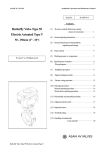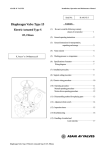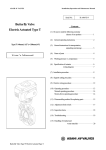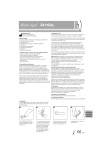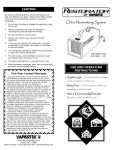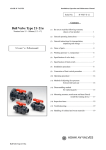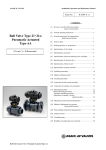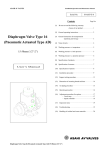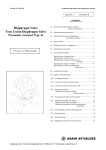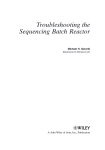Download 3-Way Ball Valve Type 23 Electric Actuated Type T
Transcript
ASAHI AV VALVES
Installation, Operation and Maintenance Manual
Serial No.
H-A054-E-7
Contents
3-Way Ball Valve Type 23
Electric Actuated Type T
User’s Manual
(1) Be sure to read the following warranty
clauses of our product
1
(2) General operating instructions
2
(3) General instructions for transportation,
unpacking and storage
3
(4) Name of parts
4
(5) Working pressure vs. temperature
6
(6) Specifications of actuator
Wiring diagram
7
8
(7) Installation procedure
10
(8) Support setting procedure
15
(9) Electric wiring procedure
16
(10) Operating procedure
Manual operating procedure
Motor-driven operating procedure
18
19
19
(11) Adjustment face pressure
between ball and seat
20
(12) Disassembling method for replacing parts
21
(13) Adjustment limit switch
22
(14) Inspection items
24
(15) Troubleshooting
24
(16) Handling of residual and
waste materials
25
ASAHI AV VALVES
3-Way Ball Valve Type 23 Electric Actuated Type T
ASAHI AV VALVES
Installation, Operation and Maintenance Manual
This user’s guide contains information important to the proper installation, maintenance and safe use of an
ASAHI AV Product. Please store this manual in an easily accessible location.
<Warning & Caution Signs>
This symbol reminds the user to take caution due to the potential for serious injury or death.
Warning
Caution
This symbol reminds the user to take caution due to the potential for damage to the valve if used in
such a manner.
<Prohibited & Mandatory Action Signs>
Prohibited: When operating the valve, this symbol indicates an action that should not be taken.
Mandatory action: When operating the valve, this symbol indicates mandatory actions that must be
adhered to.
(1) Be sure to read the following warranty clauses of our product
- Always observe the specifications of and the precautions and instructions on using our product.
- We always strive to improve product quality and reliability, but cannot guarantee perfection. Therefore,
should you intend to use this product with any equipment or machinery that may pose the risk of serious or
even fatal injury, or property damage, ensure an appropriate safety design or take other measures with
sufficient consideration given to possible problems. We shall assume no responsibility for any
inconvenience stemming from any action on your part without our written consent in the form of
specifications or other documented approval.
- The related technical documents, operation manuals, and other documentation prescribe precautions on
selecting, constructing, installing, operating, maintaining, and servicing our products. For details, consult
with our nearest distributor or agent.
- Our product warranty extends for one and a half years after the product is shipped from our factory or one year
after the product is installed, whichever comes first. Any product abnormality that occurs during the
warranty period or which is reported to us will be investigated immediately to identify its cause. Should our
product be deemed defective, we shall assume the responsibility to repair or replace it free of charge.
- Any repair or replacement needed after the warranty period ends shall be charged to the customer.
- The warranty does not cover the following cases:
(1) Using our product under any condition not covered by our defined scope of warranty.
(2) Failure to observe our defined precautions or instructions regarding the construction, installation, handling,
maintenance, or servicing of our product.
(3) Any inconvenience caused by any product other than ours.
(4) Remodeling or otherwise modifying our product by anyone other than us.
(5) Using any part of our product for anything other than the intended use of the product.
(6) Any abnormality that occurs due to a natural disaster, accident, or other incident not stemming from
something inside our product.
3-Way Ball Valve Type 23 Electric Actuated Type T
1
ASAHI AV VALVES
Installation, Operation and Maintenance Manual
(2) General operating instructions
Warning
Caution
- Do not disassemble or remodel the actuator.
- Do not operate the manual override while the actuator is energized.
- Keep hands and other extremities away from moving parts under all circumstances.
(Any such practice may get your hand, arm, or other part of your body caught.)
- Using a positive-pressure gas with our plastic piping may pose a dangerous condition due to the
repellent force particular to compressible fluids even when the gas is under similar pressures used for
liquids. Therefore, be sure to take the necessary safety precautions such as covering the piping with
protective material. For inquiries, please contact us. For conducting a leak test on newly installed
piping, be sure to check for leaks under water pressure. If absolutely necessary to use a gas in testing,
please consult your nearest service station beforehand.
- Before using the product, check the operating power supply and the voltage specification on the
nameplate. Using an improper voltage may cause equipment damage or malfunction.
- Do not step on or apply excessive weight on valve. (It can be damaged.)
- Do not use AV valves in a place where they may become submerged in water.
- Do not apply a great impact or vibration to the actuator. (Any such practice may result in breakdown.)
- Do not use the valve in conditions where the fluid may have crystallized.
(The valve will not operate properly.)
- While in operation, the actuator may rise in surface temperature. This is due to heat-up of the inner
equipment and is not a sign of a breakdown. However, exceeding the permissible temperature
may cause a breakdown.
- Keep the valve away from excessive heat or fire. (It can be damaged, or destroyed.)
- Avoid locations with corrosive gas or otherwise bad atmospheres. Install a cover or something
similar that covers the entire area.
- Always operate the valve within the pressure vs. temperature range.
(The valve can be damaged or deformed by operating beyond the allowable range.)
- Allow sufficient space for maintenance and inspection.
- Select a valve material that is compatible with the media. For chemical resistance information, refer to
“CHEMICAL RESISTANCE ON ASAHI AV VALVE”.
(Some chemicals may damage incompatible valve materials.)
- Keep the valve out of direct sunlight, water and dust. Use cover to shield the valve.
(The valve will not operate properly.)
- Perform periodic maintenance. (Leakage may develop due to temperature changes or periods of
prolonged storage, rest, or operation.)
- When installing a valve, provide an appropriate support. (Lack of such a support may cause the valve and
piping to be overstrained, resulting in damage or other defect.)
- In the case of malodor, overheating, or smoking, turn off the power supply immediately. (Continued use
despite an abnormality present may result in a fire. If you detect any abnormalities, be sure to consult
the dealership where you bought the product or our service station nearest your premises and ask them
to perform an inspection.)
- For manual operation, be sure to use the handle furnished with the product by the manufacturer.
- When using the product in explosive atmosphere, ensure that the actuator complies with the
explosion-proof specifications required for that area.
- Keep the ambient temperature of the installed location within the range -10°C and 50°C.
3-Way Ball Valve Type 23 Electric Actuated Type T
2
ASAHI AV VALVES
Installation, Operation and Maintenance Manual
(3) General instructions for transportation, unpacking and storage
- When suspending and supporting a valve, take care and do not stand under a suspended valve.
Warning
Caution
- This valve is not designed to handle impacts of any kind. Avoid throwing or dropping the valve.
- Avoid scratching the valve with any sharp object.
- Do not over-stack cardboard shipping boxes. Excessively stacked packages may collapse.
- Avoid contact with any coal tar creosote, insecticides, vermicides or paint.
(The force of swelling may damage the valve.)
- When transporting a valve, do not carry it by the handle.
- Store products in their corrugated cardboard boxes. Avoid exposing products to direct sunlight, and
store them indoors (at room temperature). Also avoid storing products in areas with excessive
temperatures. (Corrugated cardboard packages become weaker as they become wet with water or
other liquid. Take care in storage and handling.)
- After unpacking the products, check that they are defect-free and meet the specifications.
3-Way Ball Valve Type 23 Electric Actuated Type T
3
ASAHI AV VALVES
Installation, Operation and Maintenance Manual
(4) Name of parts
Nominal size 15-50mm (1/2”-2”)
No.
DESCRIPTION
[1]
Body
[2]
Ball
[3]
Carrier
[4b] End connector (Flanged end type)
[4c] End connector (Socket end type)
[4d] End connector (Threaded end type)
[5]
Union nut
No.
[6]
[7]
[8]
[9]
[10]
[11]
[12]
3-Way Ball Valve Type 23 Electric Actuated Type T
DESCRIPTION
Stem
Seat
O-ring (A)
O-ring (B)
O-ring (C)
O-ring (D)
O-ring (E)
No.
[13]
[23]
[24]
[25]
[26]
[27]
[28]
DESCRIPTION
Stop ring
Actuator
Stand
Joint
Bolt (A)
Bolt・Nut (B)
Screw (B)
4
ASAHI AV VALVES
Installation, Operation and Maintenance Manual
Nominal size 65 -100mm (2 1/2”-4”)
No.
DESCRIPTION
[1]
Body
[2]
Ball
[3]
Carrier
[4b] End connector (Flanged end type)
[4c] End connector (Socket end type)
[4d] End connector (Threaded end type)
[5]
Union Nut
No.
[6]
[7]
[8]
[9]
[10]
[11]
[12]
3-Way Ball Valve Type 23 Electric Actuated Type T
DESCRIPTION
Stem
Seat
O-ring (A)
O-ring (B)
Cushion
O-ring (D)
O-ring (E)
No.
[13]
[23a]
[24]
[18]
[19]
[20]
[21]
DESCRIPTION
Stop ring
Actuator
Stand
Joint
Bolt
Bolt・Nut
Screw
5
ASAHI AV VALVES
Installation, Operation and Maintenance Manual
(5) Working pressure vs. temperature
3-Way Ball Valve Type 23 Electric Actuated Type T
6
ASAHI AV VALVES
Installation, Operation and Maintenance Manual
(6) Specifications of actuator
List of Specifications
Actuator Type
AOC-00
AOC-0
Nominal Size
15 - 50mm (1/2” - 2”)
65 - 100mm (2 1/2” - 4”)
50Hz
10
25
60Hz
8
20
JIS C0920 WaterJet proof type
(IP65)
JIS C0920 WaterJet proof type
(IP65)
AC100V
0.80 / 0.80
1.20 / 1.20
AC110V
1.00 / 1.00
1.40 / 1.40
AC200V
0.50 / 0.50
0.50 / 0.50
AC220V
0.70 / 0.70
0.70 / 0.70
AC100V
0.40 / 0.40
0.50 / 0.50
AC110V
0.50 / 0.50
0.60 / 0.60
AC200V
0.25 / 0.25
0.25 / 0.25
AC220V
0.30 / 0.30
0.30 / 0.30
7.5
6.7
AC100V
40
50
AC110V
44
55
AC200V
50
60
AC220V
55
66
Opening and Closing
Time (Sec.)
protection structure
Motor starting current
(A)
50/60Hz
Motor rated current
(A)
50/60Hz
Number of rotations of
manual operating handle
Watt consumption (VA)
Nominal diameter of cable connector
G1/2
Motor rated output (W)
8
By kind of motor insulation
E kind
Motor rated time (min.)
Capacity of limit switch
Space heater rated output(W)
ambient temperature oC( oF)
30
AC250V 5A
AC250V 5A
2*
5
-10 - 50 oC ( 14 – 122 oF)
*Option
3-Way Ball Valve Type 23 Electric Actuated Type T
7
ASAHI AV VALVES
Wiring diaphragm Nominal Size: 15-50mm (1/2”-2”)
Installation, Operation and Maintenance Manual
Actuator Type: AOC-00
Note: The circuit diagram shows the position that the action to which the right side open has finished.
Switching chart
3-Way Ball Valve Type 23 Electric Actuated Type T
8
ASAHI AV VALVES
Wiring diaphragm Nominal Size: 65-100mm (2 1/2”-4”)
Installation, Operation and Maintenance Manual
Actuator Type: AOC-0
Note: The circuit diagram shows the position that the action to which the right side open has finished.
Switching chart
3-Way Ball Valve Type 23 Electric Actuated Type T
9
ASAHI AV VALVES
Installation, Operation and Maintenance Manual
(7) Installation procedure
- When suspending and supporting a valve, take care and do not stand under a suspended valve.
Warning
Caution
- Be sure to conduct a safety check on all hand and power tools to be used before beginning work.
- Wear protective gloves and safety goggles as fluid remain in the valve even if the pipeline is empty.
(You may be injured.)
- When installing a pipe support by means of a U-band or something similar, take care not to over-tighten.
(Excessive force may damage the pipe.)
- Take care not to over-tighten the Union Nut. (The valve can be damaged.)
- Do not use the pipe wrench. (The valve can be damaged.)
- When installing pipes and valves, ensure that they are not subjected to tension, compression, bending,
impact, or other excessive stress.
- When loosening the cap nut on the union side, fix the body cap
(hold it with your hand) and do work. (If the body cap turns,
the union will turn together, resulting in the union and ball
separating from the body.) If the union is loosened, retighten
the union.
- When installing, disassembling, or reassembling the piping, fix
the End Connector.
- Before a water test, be sure that the Union Nut is tightly fastened.
- Fasten the Union Nut while avoiding the parallelism and axial misalignment of the flange surface.
- When connecting a ASAHI AV Valve to metal piping, take care not to let the pipe stress on the ASAHI
AV Valve.
Flanged type (Material: PVC, C-PVC, PP, PVDF)
Caution
- Use flat faced flanges for connection to AV Valves.
- Ensure that the mating flanges are of the same standards.
- Be sure to use sealing gaskets (AV Gasket), bolts, nuts, and washers and tighten them to specified torques.
(When a non-AV gasket is used, a different tightening torque specification should be followed.)
Necessary items
● Torque wrench
● AV gasket
● Spanner wrench
● Bolt, Nut, Washer (For many flanges specification)
Procedure
1) When the union nut [5] flange assembly set was removed or loosen from body[1], O-ring (A) [8]should
be installed into carrier and body groove. (In either horizontal or vertical installation, if necessary apply
a small amount of lubricant to O-ring to hold in place.) Align union nut and end connector with the
body. Insure end connector mates with body and O-ring. Make certain union nut threads onto body
smoothly. Tighten union nuts on each side valve until hand tight. Then using a strap wrench tighten
union nuts uniformly on each side approx 90o -180o turns, 1/4 to 1/2 turns.
3-Way Ball Valve Type 23 Electric Actuated Type T
10
ASAHI AV VALVES
Installation, Operation and Maintenance Manual
2) Set the AV gasket between the flanges.
3) Insert washers and bolts from the pipe side, insert washers and nuts from the valve side, then
temporarily tighten them by hand.
Caution
- The parallelism and axial misalignment of the flange surface should be under the values shown (A
failure to observe them can cause destruction due to stress application to the pipe)
Unit : mm (inch)
Axial
Parallelism
(Axial misalignment)
(Parallelism)
Nom. Size
Misalignment
(a-b)
15-32mm
1.0mm (0.04”)
0.5mm (0.02”)
(1/2”-1 1/4”)
40-80mm
1.0mm (0.04”)
0.8mm (0.03”)
(1 1/2”-3”)
100mm
1.0mm (0.04”)
1.0mm (0.04”)
(4”)
4) Tighten the bolts and nuts gradually with a torque wrench to the specified torque level in a diagonal manner.
(Refer to fig.1.)
Caution
- Tighten the bolts and nuts gradually with a torque wrench to the specified
torque level in a diagonal manner.
Recommended torque value
15-20mm
Nom. Size
(1/2”-3/4”)
17.5
PTFE・PVDF
{179}
coated
[155]
8.0
Rubber
{82}
[71]
25-40mm
(1”-1 1/2”)
20.0
{204}
[177]
20.0
{204}
[177]
3-Way Ball Valve Type 23 Electric Actuated Type T
Fig. 1
Unit: N・m{kgf・cm}[lb・inch]
50, 65mm
80, 100mm
(2”, 2 1/2”)
(3”, 4”)
22.5
30.0
{230}
{306}
[230]
[266]
22.5
30.0
{230}
{306}
[230]
[266]
11
ASAHI AV VALVES
Installation, Operation and Maintenance Manual
Threaded type (Material : PVC, C-PVC, PP, PVDF)
- Avoid excessive tightening. (The valve can be damaged.)
Caution
- Make sure that the threaded connections are plastic x plastic. (Metallic thread can cause damage.)
- Wrap the threaded joints on our plastic piping with sealing tape. Using a liquid sealing agent or liquid
gasket may cause stress cracks (Environmental Stress Cracking). Our product warranty shall not apply
in case of said use, even when said use is unavoidable.
Necessary items
● Sealing tape
● Strap wrench
● Spanner wrench
Procedure
1) Wind a sealing tape around the external thread of joint, leaving the end (about 3mm) free.
2) Loosen the union nut [5] with a strap wrench..
3) Remove the union nut [5] and the end connector [4d].
4) Lead the union nut [5] through the pipe.
5) Tighten the external thread of the joint and the end connector [4d] hardly with hand.
6) Using a spanner wrench, screw in the end connector [4d] by turning 180°-360°carefully without damaging it.
*Avoid excessive tightening. (The valve can be damaged.)
7) Make sure that the O-ring (A) [8] is mounted.
8) Set the end connector [4d] and union nut [5] directly on the body without allowing the O-ring (A) [8] to come off.
9) Tighten union nuts [5] on each valve until hand tight.
10) Using a strap wrench tighten union nuts uniformly on each on each side approx 90°-180°turns, 1/4 to
1/2 turns.
*Take care not to over-tighten the Union Nut. (The valve can be damaged.)
3-Way Ball Valve Type 23 Electric Actuated Type T
12
ASAHI AV VALVES
Socket type
Warning
Caution
Installation, Operation and Maintenance Manual
(Material : PVC, C-PVC)
- When using an adhesive, ventilate the space sufficiently, prohibit the use of a fire in the vicinity, and
do not inhale adhesive vapors directly.
- If an adhesive gets into contact with your skin, wash it off immediately. If you feel sick or find
any anomaly, receive a physician's diagnosis and take appropriate measures promptly.
- Take care in doing work at low temperatures. Solvent vapors are hard to evaporate and are likely to
remain. (Solvent cracks may occur, damaging the equipment.) After assembling the piping
system, open both ends of the piping and use a fan (of the Low-Voltage Type) or something similar
to ventilate the space, thus removing the solvent vapors.
- Use the appropriate Asahi AV cement.
- Conduct a water test at least 24 hours after joining the pipes with an adhesive/cement.
Necessary items
● Adhesive for hard vinyl chloride pipes
● Strap wrench
Procedure
1) Loosen the union nut [5] with a strap wrench.
2) Remove the union nut [5] and end connector [4c].
3) Lead the union nut through the pipe.
4) Clean the hub part of the end connector [4c] by wiping the waste cloth.
5) Apply adhesive evenly to the hub part of the end connector [4c] and the pipe spigot.
* Do not apply more adhesive than necessary. (The valve can be damaged due to solvent cracking.)
Adhesive quantity (guideline)
15mm 20mm
Nom. Size
(1/2”)
(3/4”)
Quantity(g)
1.0
1.3
25mm
(1”)
32mm
(1 1/4”)
40mm
(1 1/2”)
50mm
(2”)
65mm
(2 1/2”)
80mm
(3”)
100mm
(4”)
2.0
2.4
3.5
4.8
6.9
9.0
13.0
6) After applying adhesive, insert the pipe quickly to the end connector [4c] and leave it alone for at least 60
seconds.
* Do not under any circumstances try to insert a pipe into another fitting or valve by striking it, which may
break the piping.
7)
8)
9)
10)
11)
Wipe away overflowing adhesive.
Make sure that O-ring(A) [8] is mounted
Set the end connector [4c] and union nut [5] directly on the body without allowing the O-ring (A) [8] to come off.
Tighten union nut [5] hardly with hand.
Using a strap wrench tighten union nuts uniformly on each side approx 90°-180°turns, 1/4 to 1/2 turns.
* Take care not to over-tighten the Union Nut. (The valve can be damaged.)
3-Way Ball Valve Type 23 Electric Actuated Type T
13
ASAHI AV VALVES
Installation, Operation and Maintenance Manual
Socket type (Material : PP, PVDF )
Necessary items
● Strap wrench
● Sleeve welder or automatic welding machine
● User’s manual for sleeve welder or automatic welding machine
Procedure
1)
2)
3)
4)
5)
6)
7)
8)
Loosen the union nut with a strap wrench.
Remove the union nut [5] and the end connector.
Lead the union nut [5] through the pipe.
For the next step, refer to the user’s manual for the sleeve welder or the automatic welding machine.
After welding, make sure that the O-ring (A) [8] is mounted.
Set the end connector [4c] and the union nut [5] directly without allowing the O-ring (A) [8] to come off.
Tighten union nut [5] hardly with hand.
Using a strap wrench tighten union nuts uniformly on each side approx 90°-180°turns, 1/4 to 1/2 turns.
* Take care not to over-tighten the Union Nut. (The valve can be damaged.)
Spigot type (Material : PVDF )
Necessary items
● Strap wrench
● Automatic welding machine
● User’s manual for automatic welding machine
Procedure
1)
2)
3)
4)
5)
6)
7)
8)
Loosen the union nut with a strap wrench.
Remove the union nut [5] and the end connector.
Lead the union nut [5] through the pipe.
For the next step, refer to the user’s manual for the sleeve welder or the automatic welding machine.
After welding, make sure that the O-ring (A) [8] is mounted.
Set the end connector [4e] and the union nut [5] directly without allowing the O-ring (A) [8] to come off.
Tighten union nut [5] hardly with hand.
Using a strap wrench tighten union nuts uniformly on each side approx 90°-180°turns, 1/4 to 1/2 turns.
* Take care not to over-tighten the Union Nut. (The valve can be damaged.)
3-Way Ball Valve Type 23 Electric Actuated Type T
14
ASAHI AV VALVES
Installation, Operation and Maintenance Manual
(8) Support setting procedure
- Do not subject the valve to pump vibrations. (The valve may be damaged.)
Caution
- Valves must be supported. (The valve may be damaged by the weight of the actuator if it is unsupported.)
Necessary items
● Spanner wrench
● U-type clamp (with bolt)
● Rubber sheet
Level installation
Spread the rubber sheet on the pipe and secure pipe with
U-type clamp.
In case that the actuator is under the pipe, spread the
rubber sheet under the pipe, then set the stand.
Perpendicular installation
Spread the rubber sheet on the pipe and fix pipe with
U-type band.
3-Way Ball Valve Type 23 Electric Actuated Type T
15
ASAHI AV VALVES
Installation, Operation and Maintenance Manual
(9) Electric wiring procedure
Warning
Caution
- Do not touch any parts on actuator circuit board or terminal clock or connect or disconnect wires while
the actuator is energized. (Any such practice may result in an electric shock or equipment damage.)
- Do not operate the manual override while the actuator is energized.
- Keep hands and other extremities away from moving parts under all circumstances.
(Any such practice may get your hand, arm, or other part of your body caught.)
- Be sure to establish a ground. (A defective ground may result in an electrical shock, fire, or other incident.)
- At the time of adjustment or inspection, ensure that your hands are free of water and oil.
(Any such substance on your hands may result in an electric shock or equipment damage.)
- Do not exceed the rated capacity of limit switch contacts. If you wish to apply very small loads
(1-100 mA, 5-30 V), consult our service station nearest to you.
- Do not connect two or more motor-driven valves in series. Also, install a switch (or a relay contact)
for each motor-driven valve.
- Do not use the product near high-voltage wire, inverter, or any other equipment that produces
electrical noise or magnetism. (The presence of such nearby may cause malfunction or breakdown.)
- Check the integrity of wiring insulation before connecting to the actuator.
(Failure to observe this precaution may result in wire damage.)
- Ensure all covers are tightly fastened prior to operation.
(Insufficient fastening may allow rainwater, dust, or dirt to come in, resulting in breakdown.)
- When connecting wires, be sure to observe the connection diagram and make the connections
correctly. Moreover, after wiring, ensure that the connections are securely made before turning on
the power. (Failure to take this precaution may cause malfunction or breakdown.)
- Each cover part is sealed with an O-ring. When laying wiring or in similar cases, where the cover is
removed and replaced, ensure that the O-ring is installed in the specified location and securely
sealed. (Insufficient sealing may cause the actuator to be penetrated by rainwater or other foreign
matter, resulting in electric shock or breakdown.)
- If you wish to use the product outdoors or in any other location exposed to rainwater or other forms
of moisture, protect the wiring conduit of the actuator against ingress of rainwater and all other
wetness. (Failure to take such a precaution may cause the actuator to be penetrated by rainwater or
something similar, resulting in electric shock or breakdown.)
- In the case of malodor, overheating, or smoking, turn off the power supply immediately. (Continued
use despite an abnormality present may result in a fire. If you detect any abnormalities, be sure to
consult the dealership where you bought the product or our service station nearest your premises
and ask them to perform an inspection.)
Necessary items
● Spanner wrench
● Terminal crimping tool
● Connecter
● Wire stripper
● Allen wrench
● Crimp-style terminal
● Screwdriver (+)
*Check supply voltage indicated on the actuator and make sure it is the same as the voltage applied, before completing
the wiring. (Wiring at different voltages will cause problems in the AV valve.)
3-Way Ball Valve Type 23 Electric Actuated Type T
16
ASAHI AV VALVES
Installation, Operation and Maintenance Manual
Procedure
1) Loosen the 4 screws fixing the switch cover, using a Phillips
screwdriver (AOC-00) or Allen wrench (AOC-0), and open the cover.
For wiring the model AOC-00 being used in vertical piping, open the
cover, slide the stopper, and fix the cap.
2) Loosen and remove the protection screws in the lead port, using an
adjustable wrench.
3) Mount a connector on the lead port.
4) Lead a cable through the connector.
5) Peel off the outer shell of the cable, using a wire stripper.
6) Attach a crimping terminal, using a terminal crimping tool.
7) Connect wires on the terminal block, using a Phillips screwdriver, as
described in the pages 8 and 9.
* Tighten the screws firmly.
(Electricity leak or electric shock may be caused.)
8) Tighten the connector.
* Tighten the connector firmly. (Ingression of storm water may be
resulted, causing electricity leak or electric shock.)
9) Connect a grounding wire. (refer to the page 8, 9)
- On the screw on the rear of the body for the model AOC-00
- On the terminal for the model AOC-0
10) Tighten the 4 screws fixing the actuator cover, using a Phillips
screwdriver (AOC-00) or Allen wrench (AOC-0), to install the cover.
Actuator Type: AOC-00
Screw
Cover
Cable entrance
Actuator Type: AOC-0
Allen screw
Cover
Cable entrance
3-Way Ball Valve Type 23 Electric Actuated Type T
17
ASAHI AV VALVES
Installation, Operation and Maintenance Manual
(10) Operating procedure
Warning
Caution
- Do not touch any parts on actuator circuit board or terminal clock or connect or disconnect wires while
the actuator is energized. (Any such practice may result in an electric shock or equipment damage.)
- Do not operate the manual override while the actuator is energized.
- Keep hands and other extremities away from moving parts under all circumstances.
(Any such practice may get your hand, arm, or other part of your body caught.)
- Be sure to establish a ground. (A defective ground may result in an electrical shock, fire, or other
incident.)
- At the time of adjustment or inspection, ensure that your hands are free of water and oil.
(Any such substance on your hands may result in an electric shock or equipment damage.)
- Do not connect two or more motor-driven valves in series. Also, install a switch (or a relay contact)
for each motor-driven valve.
- Do not use the product near high-voltage wire, inverter, or any other equipment that produces
electrical noise or magnetism. (The presence of such nearby may cause malfunction or breakdown.)
- Check the integrity of wiring insulation before connecting to the actuator.
(Failure to observe this precaution may result in wire damage.)
- Ensure all covers are tightly fastened prior to operation.
(Insufficient fastening may allow rainwater, dust, or dirt to come in, resulting in breakdown.)
- When connecting wires, be sure to observe the connection diagram and make the connections
correctly. Moreover, after wiring, ensure that the connections are securely made before turning on
the power. (Failure to take this precaution may cause malfunction or breakdown.)
- Each cover part is sealed with an O-ring. When laying wiring or in similar cases, where the cover is
removed and replaced, ensure that the O-ring is installed in the specified location and securely
sealed. (Insufficient sealing may cause the actuator to be penetrated by rainwater or other foreign
matter, resulting in electric shock or breakdown.)
- If you wish to use the product outdoors or in any other location exposed to rainwater or other forms
of moisture, protect the wiring conduit of the actuator against ingress of rainwater and all other
wetness. (Failure to take such a precaution may cause the actuator to be penetrated by rainwater or
something similar, resulting in electric shock or breakdown.)
- In the case of malodor, overheating, or smoking, turn off the power supply immediately. (Continued
use despite an abnormality present may result in a fire. If you detect any abnormalities, be sure to
consult the dealership where you bought the product or our service station nearest your premises
and ask them to perform an inspection.)
3-Way Ball Valve Type 23 Electric Actuated Type T
18
ASAHI AV VALVES
Installation, Operation and Maintenance Manual
Manual Operating Procedure
Caution
- Turn off the power source.
(If the power source is turned on during the manual operation, you may be injured.)
Necessary items
●Manual operating Lever (*Option: AOC-00) or allen wrench (5mm)
Procedure
1) Put the allen wrench in the hexagon socket of the
manual operation shaft of the actuator.
2) Fully open the valve once or twice while watching the
valve travel indicator.
Right turn (clock wise)
→ Left open direction
Left turn (counter clock wise) → Right open direction
* Do not turn the handle forcibly at the right and left full operating positions. (If not, a trouble will develop.)
3)
Remove the allen wrench from the manual operation shaft in state where the valve is opened fully.
Motor-Driven Operating Procedure
Warning
- Do not leave the cover removed from the actuator.
(Coming into contact with a terminal in this state can give you an electric shock.)
- Check to ensure that the spanner is not applied to the end of the manual operation shaft.
(If not, the hexagon wrench will be flown by the rotation of the manual operation shaft, and this may
injure you)
Procedure
1) Turn on the power source.
2) Set the external switch to “Left open” or “Right open”, and check to ensure that the valve indicating direction and the
operating direction agree with each other.
3) Turn off the power source in the state of the Left open or Right open.
3-Way Ball Valve Type 23 Electric Actuated Type T
19
ASAHI AV VALVES
Installation, Operation and Maintenance Manual
(11) Adjustment face pressure between ball and seat
Caution
- Take care not to over-tighten the Union Nut. (The valve can be damaged.)
- Do not use the pipe wrench. (The valve can be damaged.)
- Wear protective gloves and safety goggles as fluid remain in the valve even if the pipeline is empty.
(You may be injured.)
Necessary items
● Strap wrench
● Handle [14](*Option)
● allen wrench (5mm)
● Protective gloves
● Safety goggles
Procedure
1)
2)
3)
4)
5)
6)
7)
8)
9)
Completely discharge fluid from pipes.
Fully close the valve at right or left by the motor-driven
operation.
Turn off the power source.
Loosen three union nuts [5] with a strap wrench.
Remove the body part from piping system.
Engage the upper convex part of the handle [14] with the
concave part of the union.
* Only the union [3] on the right side when viewed from
the trademark (AV mark) can be adjusted.
Make an adjustment by turning the union clockwise (to tighten
it ) or counter clockwise (to loose it).
Make sure that the handle can be operated smoothly.
Assemble the valve by following the above procedure in the
reverse order, starting at 5).
Direction where carrier is tightened
Handle [14]
Direction where
carrier is loosened
3-Way Ball Valve Type 23 Electric Actuated Type T
20
ASAHI AV VALVES
Installation, Operation and Maintenance Manual
(12) Disassembling method for replacing parts
Warning
Caution
- Do not disassemble or remodel the actuator.
- Do not touch any parts on actuator circuit board or terminal clock or connect or disconnect wires while the
actuator is energized. (Any such practice may result in an electric shock or equipment damage.)
- Do not change or replace valve parts under line pressure.
- Be sure to conduct a safety check on all hand and power tools to be used before beginning work.
- Wear protective gloves and safety goggles as fluid remain in the valve even if the pipeline is empty.
(You may be injured.)
- Ensure all covers are tightly fastened prior to operation.
(Insufficient fastening may allow rainwater, dust, or dirt to come in, resulting in breakdown.)
- The actuator has been adjusted at the factory. If reconfiguration or adjustment is needed, do so
correctly according to the relevant operation manual.
(Failure to observe this instruction may cause malfunction or breakdown.)
- Each cover part is sealed with an O-ring. When laying wiring or in similar cases, where the cover is
removed and replaced, ensure that the O-ring is installed in the specified location and securely sealed.
(Insufficient sealing may cause the actuator to be penetrated by rainwater or other foreign matter,
resulting in electric shock or breakdown.)
Necessary items
● Strap wrench
● Protective gloves
● Allen wrench (5mm)
● Safety goggles
<Disassembly>
Procedure
1) Completely discharge fluid from pipes.
2) Fully open the valve at left by motor-driven operations.
3) Turn off the power source.
4) Loosen the union nut [5] with a strap wrench.
5) Remove the body from the piping system.
6) Loosen the bolt [26], and remove actuator [23] from stand.
7) Loosen the set screw [28] with an allen wrench, and remove joint
[25] from stem [6].
8) Loosen nut and bolt [27] with a spanner wrench, and remove stand
[24] from the top flange.
9) Engage the upper convex part of the handle [14] with the concave
part of the union.
* Only the union [3] on the right side when viewed
from the trademark (AV mark) can be adjusted.
10) In the engaged state, turn the handle [14] counter clockwise to loosen
it and remove the union [3].
11) Remove the seat [7] carefully by hand without damaging it.
12) Push out the ball [2] by hand.
13) Push out the stem [6] from the top flange side to the body side.
3-Way Ball Valve Type 23 Electric Actuated Type T
● Handle [14](*Option)
● Spanner wrench
Direction where carrier is tightened
Handle [14]
Direction where carrierisloosened
21
ASAHI AV VALVES
Installation, Operation and Maintenance Manual
<Assembly>
Procedure
Carry out the assembly work in the reverse procedure from item 10)
* With regard to item 11), before installing seat [7] on the valve, check the seat for its face and back. depression side =
engagement with ball (Refer to page 4, 5)
(13) Adjustment limit switch
Warning
- Shut down the power on the equipment before connecting wires. There are risks of electrical shock
depending on the level of operating voltage.
- Be sure that the cover is put on during operation.
Caution
- If you plan to operate limit switches at 1mA-100mA or 5-30V, consult your nearest Asahi dealer.
- The model AOC-00 is not allowed with a transitional adjustment of the open ratio of the valve by
adjusting the limit switch.
In case of adjusting the open/close limit switch, make sure to loosen the nuts fixing the stopper bolts
and turn the stopper bolts 4 to 5 times to the loosening direction. (No adjustment of the open/close
limit switch is normally required, as it is adjusted at factory shipment.)
Nominal size 15-50mm (1/2”-2”) Actuator Type: AOC-00
Necessary items
● Screw driver (+)
● Manual operation handle (option for 15 to 50 mm) or Allen wrench (5 mm)
Procedure
Nut
Stopper bolt
1) Turn off the power and completely drain the fluid within piping.
2) Manually turn the valve toward the full-open direction, using an
Allen wrench or the manual operation handle (option). (Refer to the
page 18.)
3) Loosen and open the actuator cover, using a screw driver (+), and
pull out the open ratio indication plate upward.
4) Loosen the two locking screws fixing the cam on the stem, using a
screw driver (+).
5) Turn the cam clockwise until contacts two limit switches. (Please be
sure to confirm the cam contacts two limit switches by clicking
sound.) The cams are divided into upper and lower. The upper
cam is for the contacting limit switch of clockwise direction and the
lower cam is for counterclockwise direction.
6) While holding the cam, tighten it with the two locking screws, using
a screw driver (+).
7) Referring to the page 18, confirm the travel position is in the
demanded position. If not, back to the steps 4), 5) and 6) to repeat
the adjustments.
8) Remove the Allen wrench from the manual operation shaft.
9) Mount the open ratio indication plate. Place and tighten the actuator cover, using a Phillips screwdriver.
3-Way Ball Valve Type 23 Electric Actuated Type T
22
ASAHI AV VALVES
Installation, Operation and Maintenance Manual
Limit switches (no-volt)
10) Referring to the page 18, alternately bring the limit switch to the full
counterclockwise and full clockwise positions, applying the motor
power. Confirm that the indication of the open ratio is in the position
of “O” for full counterclockwise or “S” for full clockwise.
Upper swith:Clockwise direction
Lower swith:Counterclockwise direction
Limit switches
Nominal size 65-100mm (2 1/2” – 4”) Actuator Type: AOC-0
Necessary items
● Allen wrench (3mm)
Cam
Upper switch:Clockwise direction
Lower switch:Counterclockwise direction
● Screw driver (+) ● Manual operation handle or Allen wrench (5 mm)
* In case of adjusting the open/close limit switch, make sure to loosen the nuts fixing the stopper bolts and turn the
stopper bolts 4 to 5 times to the loosening direction. (No adjustment of the open/close limit switch is normally required,
as it is adjusted at factory shipment.)
Procedure
1) Turn off the power supplied to the actuator and completely drain
The cam for clockwise direction
the fluid within piping.
2) Loosen and remove the Allen bolts in the actuator cover, using an
Allen wrench. Pull out the indicator upward.
3) Manually turn the cam toward a position corresponding to the
desired open ratio (open at right or open at left), using the manual
operation handle. (Refer to the page 18.)
4) Loosen the setscrews for the limit switch cam to be adjusted, using
an Allen wrench.
5) Move the cam toward the direction of the desired adjustment.
Confirm that the limit switch operates.
The cam for counterclockwise direction
6) While holding the cam, tighten the setscrews, using an Allen wrench.
The positions where the limit switch makes contacts are stop
positions for full counterclockwise and full clockwise. Positions for
signal outputs are 2 to 3 % before the contact positions.
7) Referring to the page 18, turn the limit switch cam to the position
where the cam makes contacts with the limit switch of clockwise
direction. Turn the clockwise direction stopper bolt by hand to its
end, and, from there, return by 1/4 to 1/2 revolution toward the
loosening direction. Tighten the nuts.
Similarly to the above, adjust the counterclockwise direction; turn
the limit switch to the position where the cam makes contacts with
the limit switch of counterclockwise direction. Adjust the
LSS: Clockwise no-volt
counterclockwise direction stopper bolt, similarly to the clockwise.
LSO: Counterclockwise no-volt
Confirm that the desired open ratio is attained by manually
SLS: Clockwise limit
operating the cams.
OLS: Counterclockwise limit
Repeat the steps 3) through 6) above, in case of insufficient
adjustment.
8) Place and tighten the actuator cover, using a screwdriver (+).
9) Referring to the page 18, alternately bring the limit switch to the open at right or open at left positions, applying the
motor power. Confirm that the indication of the open ratio is in the position of “O” for full counterclockwise or
“S” for full clockwise.
3-Way Ball Valve Type 23 Electric Actuated Type T
23
ASAHI AV VALVES
Installation, Operation and Maintenance Manual
(14) Inspection items
Caution
- Perform periodic maintenance. (Leakage may develop due to temperature changes or over periods of
prolonged storage, rest or operation.)
○ Periodically inspect and maintain the AV valve in accordance with the decided schedule.
Portion to be inspected
Inspection item
- Existence of rust, peeling of paint, and dirt of inspection hole of valve
travel indicator.
- Tightening condition of respective threaded portions. (Loose or not)
- Existence of rust and corrosion around the limit switch, and existence of
internal disconnection.
- Existence of rust and corrosion of terminal board, and existence of
Actuator
disconnection.
- Existence of abnormality in opening and closing operating sounds.
- Smooth operation of manual handle.
*It is unnecessary to supply oil to this actuator, because molybdenum
disulfide (MoS2) is used as a lubricant in the actuator.
- Existence of scratches, cracks, deformation, and discoloring.
Valve
- Existence of leakage from the valve to the outside.
- Existence of leakage when the valve is opened fully at right or left.
(15) Troubleshooting
Problem
Cause
The valve has already been opened fully.
Treatment
Turn the handle in the reverse
direction.
The valve is kept as it is electrified in the
direction reverse to the handle operating Turn of the power source.
direction.
The handle is not (can’t
Disassemble the valve to remove
be)turned when the valve is Foreign matter is in the valve.
foreign matter. (Refer to page 21)
operated manually.
The torque of the valve is increased by the
Remove the piping stress.
piping stress.
The torque is increased by the influence
Check service condition.
(temperature, components, pressure) of fluid
(Refer to page 6)
on the valve.
The power source of the control panel is
Turn on the power source.
turned off.
The valve does not operate by The actuator is disconnected.
motor-driven
Open and close are electrified
operations
simultaneously
Check the connection again.
(Refer to page 8, 9)
The actuator is connected wrongly.
3-Way Ball Valve Type 23 Electric Actuated Type T
24
ASAHI AV VALVES
Installation, Operation and Maintenance Manual
Problem
Cause
The supply voltage is wrong.
The voltage is low.
The valve does not operate by
Foreign matter is in the valve.
motor-driven
operations
The torque of the valve is increased by the
piping stress.
The torque is increased by the influence
(temperature, components, pressure) of fluid
on the valve.
The carrier is loosened.
The seat is worn.
Fluid leaks from the valve
even when the valve is closed
fully.
The seat and ball are scratched.
Foreign matter is in the valve.
The union nut is loosened.
The O-ring is scratched or worm.
Fluid leaks from the valve.
The O-ring is projected from the groove.
The sliding face or the fixed face of the
O-ring is scratched or worm.
The actuator operates, but the The stem or the joint is broken.
valve is not
The engagement between the stem and
opened or close.
the ball is broken.
Treatment
Check voltage with a tester and set
specified voltage.
Disassemble the valve to remove
foreign matter. (Refer to page 21)
Remove the piping stress.
Check service condition.
(Refer to page 6)
Adjust the face pressure between the
ball and the seat.
(Refer to page 21)
Replace the seat with a new one.
(Refer to page 21)
Replace the scratched seat and ball
with new ones.
(Refer to page 21)
Discharge the foreign matter from the
valve by opening and closing the
valve several times.
Tighten up the union nut.
Replace the O-ring with a new one.
(Refer to page 21)
Replace the sliding face or the fixed
face with a new one.
(Refer to page 21)
Replace the stem or the joint with a
new one.
Replace the engagement with a new
one.
(16) Handling of residual and waste materials
Warning
- Make sure to consult a waste treatment dealer for recommendations on the proper disposal of plastic
valves. (Poisonous gas is generated when the valve is burned improperly.)
3-Way Ball Valve Type 23 Electric Actuated Type T
25
ASAHI AV VALVES
Installation, Operation and Maintenance Manual
3-Way Ball Valves Type 23
Electric Actuated Type T
[Automatic Valve]
ASAHI AV VALVES
Distributor
Asahi Organic Chemicals Industry’s homepage
Information in this manual is subject to change without notice.
3-Way Ball Valve Type 23 Electric Actuated Type T
http://www.asahi-yukizai.co.jp/en/
2011.6



























